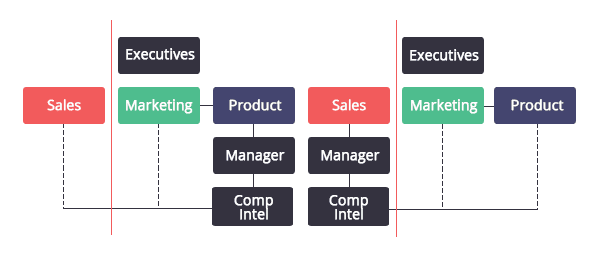Klue Compete
The Competitive Enablement Platform
Learn More
INTRODUCING KLUE INSIGHTS
FIND OUT MORE >

We’re exploring the impact that the reporting structure of your competitive intelligence (CI) team will have on the effectiveness of your program. This post is part of our Competitive Intelligence Expert Series. If you’re looking to learn more about how to build a high-performing CI program, you can find a running log of all of the CI articles here. Subscribe to the series to make sure you never miss an article or resource.
Competitive intelligence, market insights, competitive enablement. Call it whatever you want. Choosing where this function sits in your company, however, is a more complicated matter. Your competitive intelligence reporting structure has a serious impact on the type of competitive content that you build and the value your CI program will add to your business.
Everyone in your organization wants a piece of competitive intelligence. As a result, whoever in your organization is responsible for managing competitive intelligence has deliverables to all levels of the organization, which typically includes:
Which is most important? Depends on who you ask.
Who you report in to will create challenges for your competitive intelligence program and how effective your content will be in helping your stakeholders. We’ve summarized a list of the common pitfalls that CI teams fall victim to when creating competitive content:
The focus of the battlecard is to help your Sales team win more deals. However, if the competitive intelligence reporting line is into Product, the creators of this content may not have the same incentive or enough of a window into the sales process to understand what content is truly impactful to change the outcome of a deal.


In our experience, a CI Program is not only impacted by reporting lines, but also by the size of the company. A smaller company usually has fewer resources to invest into it’s competitive program. The challenges faced are usually around the burden of tracking multiple competitors and the administration of effectively sharing that intel out to Sales teams and responding to Sales requests. At a large company, centralizing intel sourced from separate teams (Product, Sales, Marketing, Exec) and external sources is difficult. Similar challenges in distributing competitive content (sales battlecards) doesn’t seem to go away as a company gets larger. We’ve outlined some of the common challenges faced by CI teams at different stages of company growth, and provided a few key tips to help improve your performance.
At smaller companies (sub 200-500 employees) it’s usually a Product Marketer who owns sales battlecards as one of their many responsibilities. They’ll produce battlecards once a year or perhaps twice depending on the importance in the organization. The once a year battlecard often has a dual purpose. These are written to provide Executives insight into the competitive landscape and to help sales to win more deals. Herein lies the issue. Battlecards created for Executives are helpful, but not optimized for sales rep consumption. What’s the difference between Executive Battlecards and Sales Battlecards you ask? Well, we’ll tell you.
When your Sales team consumes your battlecards, the content needs to be adjusted to suit their needs. Here are some brief highlights of what type of content to include (Check out our series Competitive Battlecards 101 for more examples):
Executive content, typically built for board meetings, is not formatted for easy sales consumption. It will provide sales with a ton of information but won’t help them understand how to use it to win a deal. If your sales team is able to easily understand intel about the competition and know how to apply it, they can be more agile on sales calls and increase the chances of closing a deal. For the product marketers benefit, it will help your team stay on point with messaging while giving them room to maneuver and adjust their stories as needed.
In smaller organizations, it’s critical to keep CI as a priority. We often see CI initiatives de-prioritized in favor of “more important” projects only to come up as the most important and immediate need months down the road. We’ve seen CI increase win rates, shorten deal cycles and minimize discounting. For smaller companies, putting effort into enabling your sales team with competitive content can be a game changer.
Competitive intelligence as a function gets more complex as the company’s size increases. In bigger organizations, silo’s are more prevalent and CI can report into Product team or directly into Sales. Just by looking at the reporting lines, you can tell there will be communication challenges in terms of creating, collaborating and distributing content.
Competitive intelligence reporting to Product generally results in sales content being outdated and less of a priority. Executives and product teams will be the focus and the content is typically used to help define company and product strategy. CI teams that report into this group will re-purpose this content into battlecards for sales. This usually means, it’s written for product and not written to optimize for sales usefulness. Examples, without throwing anyone under the bus, include extensive (as in, 60-page) powerpoints on the competition or equally long word documents on industry trends. CI teams that create these are not producing content that is optimized to help sales close more deals.
Competitive intelligence reporting to Sales means battlecards are more frequently updated, and positioned effectively to help salespeople de-position the competition. As a result, the demand is high for these resources from the sales team and their performance is based on how they have helped influence sales.
Tying performance to sales outcomes is very important. The downside is that too much focus is put on winning a deal as opposed to sharing changes in competitive strategies up to Exec, Product or Marketing teams. It’s important that teams with competitive intelligence reporting to Sales still have a clear and direct line of communication to marketing to ensure that the company’s messaging stays on point and any concerns can be escalated to the appropriate users. It’s when CI reports to Sales that we start to see slippage in messaging and combative relationships between the sales and marketing teams.
Often we see companies who don’t take competitive strategy seriously until it’s too late. The old-school mindset of focusing on yourselves and not competitors just doesn’t make sense in a world where prospects do the majority of their solution evaluation before ever picking up the phone with a sales rep. A proactive approach to creating competitive strategies and enabling all teams across your organization with the intel they need to do their jobs is becoming a foundational function of any successful business.
No matter who competitive intelligence reports to or how big your company is, here are some recommendations that can help your CI team build content to help Sales win more deals because in the end, bringing in more revenue to your company will always help to build your influence:
Competitive intelligence is heavily influenced by the actions of other competitors and will vary by your industry and size of company. There is no easy way to predict or guarantee reporting line for your CI team will work effectively within your organization. Here are some ideas that might help ensure that your CI team focuses on helping your sales team win more deals:


Competitive Enablement
The topic of Large Language Models (LLMs) has a lot of confusion. Here's what you need to know about how Klue is working with them.


Competitive Enablement
Product Marketing
If your competitive intel game is too strong for automation, too pure for data privacy, and too rebellious for accuracy — then Klue AI is probably not for you.


Let’s do it. Tell us a bit about yourself and we’ll set up a time to wow you.
Let's do it. Tell us a bit about yourself and we'll set up a time to wow you.
XLet's do it. Tell us a bit about yourself and we'll set up a time to wow you.
XSubscribe to get our latest AI functionality and news in your inbox.
XOur Buyer Pulse feature, set to launch in Q2 2024, offers valuable insights into the factors influencing buyer decisions in your pipeline. By signing up for the waitlist, we can better gauge interest and proactively engage with you to streamline the setup and integration process before the feature becomes widely available.
X